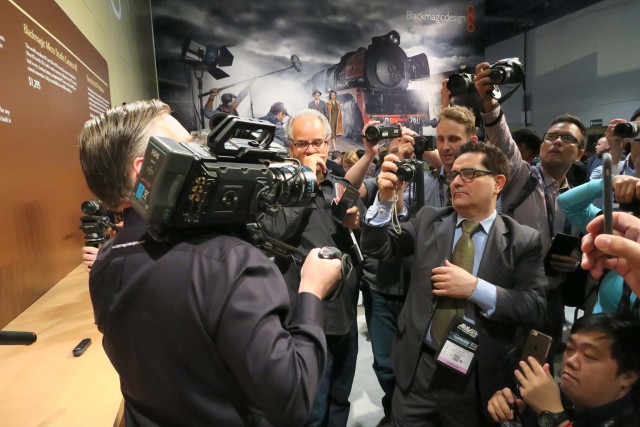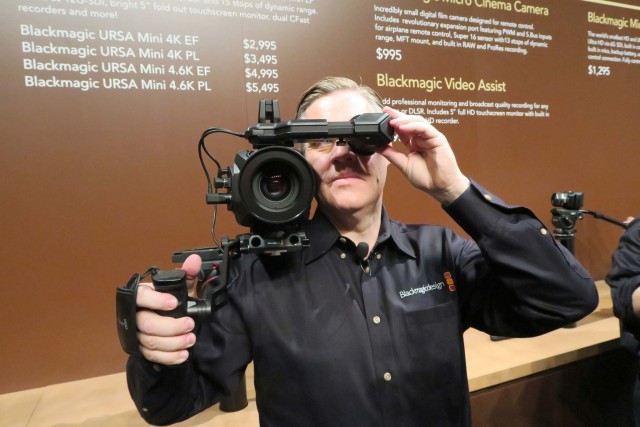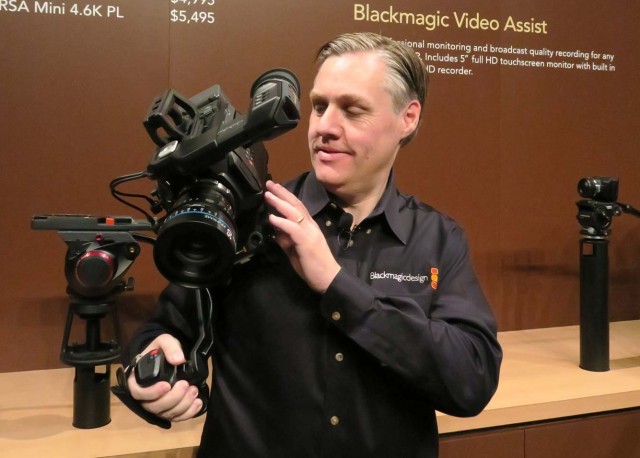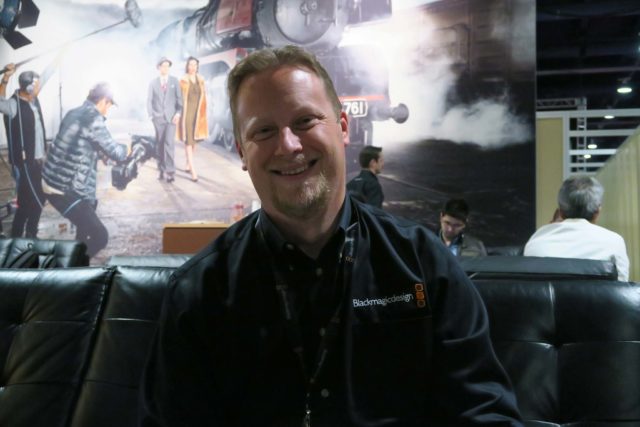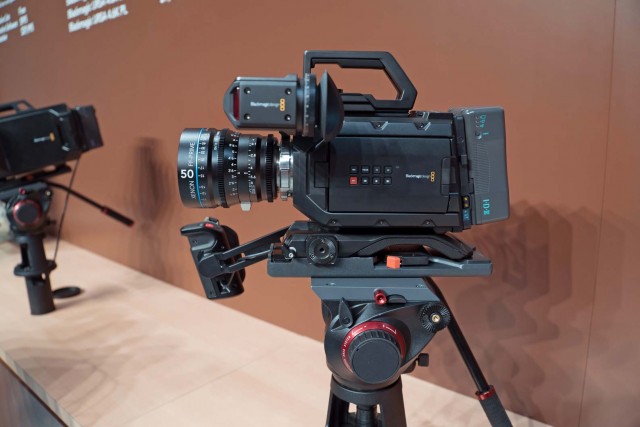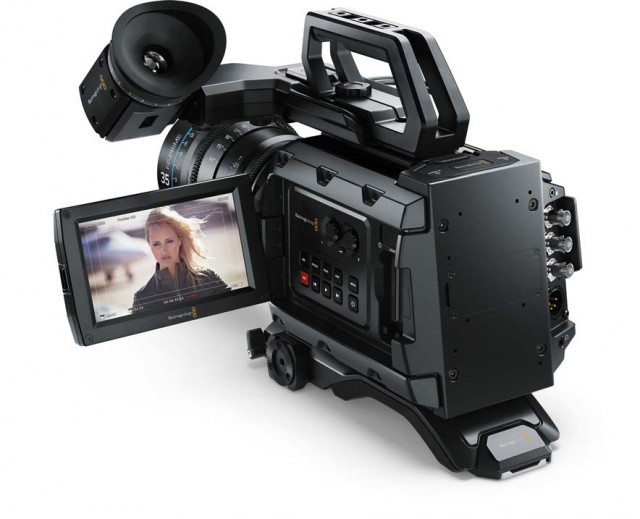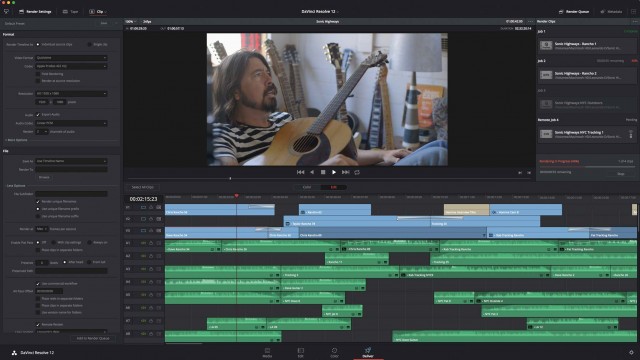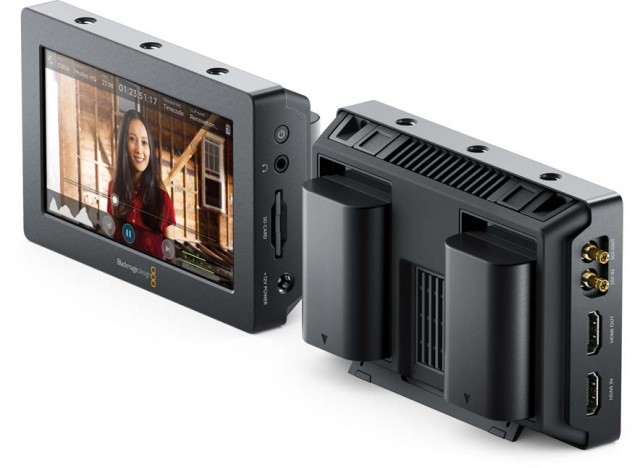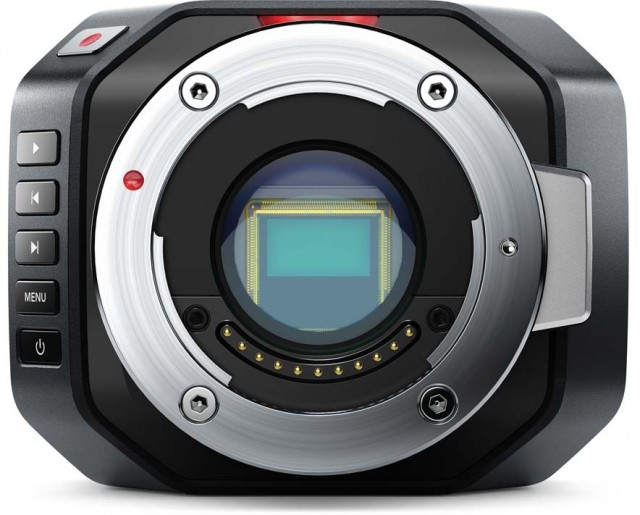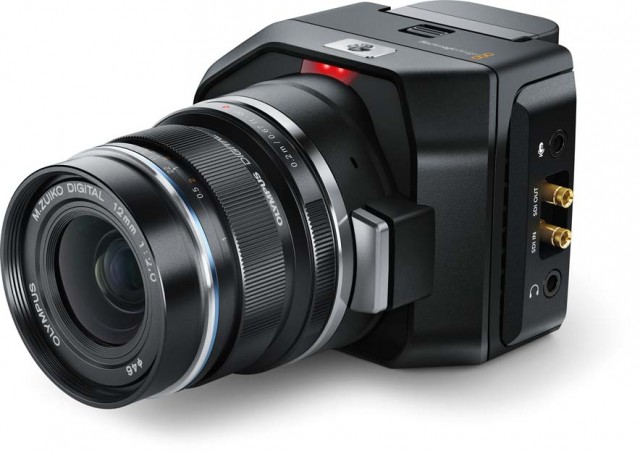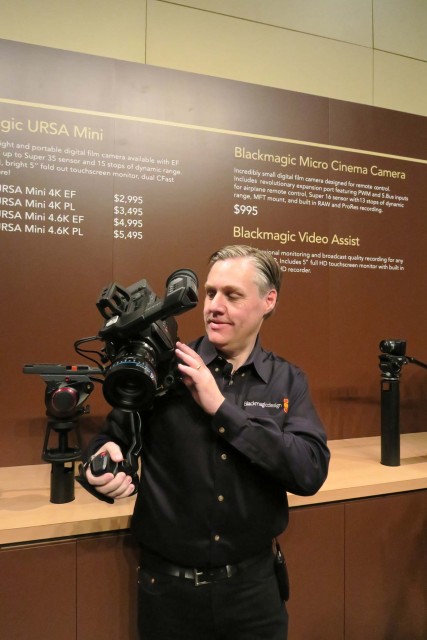Blackmagic Design inevitably begins NAB with a bang, and this year didn’t disappoint. Blackmagic CEO Grant Petty unveiled a plethora of new products, including the new URSA Mini digital motion picture camera.
A few hours later, I was back in the Blackmagic booth for a follow-up with Dan May, President of Blackmagic Design. He’s in charge of video product sales for the USA, Canada and South America. It’s always interesting to spend time with Dan at NAB for an in-depth guided tour. Dan puts things in perspective, explaining not only the what and how of new equipment, but why.
JON FAUER: It seems that you introduced more new products at NAB 2015 than ever before.
DAN MAY: We as a company have grown a lot over the last five years and we have made a number of acquisitions. We have had a number of opportunities with new product lines, new development, and the team has grown considerably. When you come to a show like this and are able to bring some 16 or 17 press releases and 38 new products, it’s not without challenges. We want to be able to inform everyone about all these amazing announcements that we’ve done. Some of them will outshine other products, even though they’re all important and even though they all have a really important message behind them. But, for better or for worse, cameras take a lot of the glory because almost every production starts with a camera. No matter whether you’re doing live production, post-production, content creation or filmmaking, there’s a camera involved. However, we feel that our other products, Resolve, Fusion, 12G hardware are equally important.
How long have you been working on these new cameras?
This is the first sensor that we’ve had custom developed for us, so it’s been a little bit of a longer development cycle. The original URSA had basically off-the-shelf sensors. With the Mini, we went out and identified a great sensor that we could work with, add a bit of extra color science and debayering. That was great, but we really wanted a sensor developed the way that we would like it to be. Blackmagic has a pretty rapid development cycle, so things like the Micro cameras have come along pretty quickly. The URSA Mini is something that we knew was in the roadmap and as we were designing URSA to be a full-sized camera that could have multiple uses, we knew that there would have to be this follow-up version of the camera. The funny part is I jokingly said that we only came with 38 products. But I could come here with 80 products if we could get everything done that we’re working on or thinking about. We have more ideas than we can get out the door.
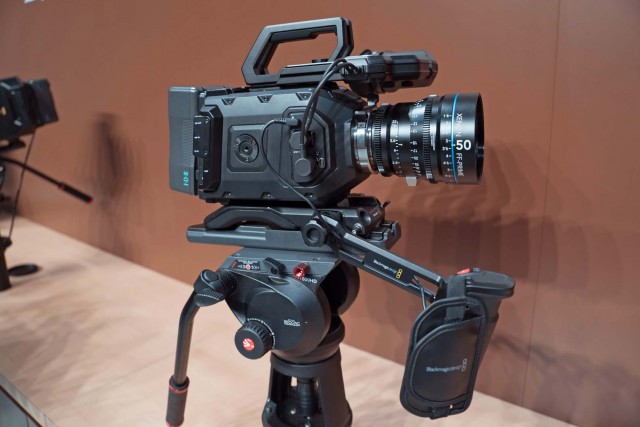
URSA Mini with Shoulder Kit (helpful Hirth-tooth rosettes on camera right side of body and both sides of kit).
Who decides what gets done, when?
Grant Petty decides all those things. There are a lot of people empowered to make decisions throughout the company and how we do things, but for all intents and purposes, Grant is the decision-maker.
So you had a green light. Sounds just like a Hollywood studio.
Yep, absolutely. There’s got to be someone with both hands on the wheel who can say this is the direction we need to go and how fast. Sometimes there are different lanes and different avenues, but particularly for product development, as CEO he¹s the final decision-maker of that road map..
Did customer input influence design of the URSA Mini?
There has been a tremendous amount of feedback from URSA in general, which we largely expected. But we basically had a catalogue of what we knew, what we prioritized, what we could do, and what we couldn’t do. We had a lot of feedback that we took into consideration as we built URSA Mini.
There are four versions. We have a 4K version and a 4.6K version. They come in EF and PL. Because the 4K version uses the 4K sensor that we use now, it is more affordable.
The 4.6K sensor is a basic $2,000 upgrade. It has 15 stops of dynamic range, a wider ISO range that is natively 800. It has the ability to do high frame rates up to 60 fps. The URSA Mini records to CFast 2.0 cards in dual slots, just like the regular URSA camera. It will do the same kind of ProRes and Raw recording as well.
The big difference you see between the URSA and the URSA Mini is size. URSA Mini is meant to be a handheld, single-user camera, so it’s lighter, under seven pounds for the basic body. The lens mount and sensor assembly is not upgradeable like the URSA. If you’re buying an URSA Mini, that’s essentially the hardware that you’re buying, like most cameras. The URSA is able to deal with higher frame rates because it has the electronics and the cooling capabilities to do that higher frame rate. URSA Mini does essentially half the frame rate (60 fps) that the full URSA can do (120 fps). So there are advantages to working with the URSA but the URSA Mini has a tremendous amount of capability for the price point that that’s coming at. With the 4K version starting at $3,000, the 4.6K version is going to be $2,000 more. A lot of people will say “well worth it”, especially for that extra dynamic range.
Back when we made the original pocket camera, Grant had a great line that you can always make a small camera bigger.
URSA is a big camera. You can’t make it smaller without a re-design. URSA Mini is something that can be made bigger, can be used hand-held, and people will understand what to do with that. There are a lot of design decisions that we’re quite pleased with.
Is there anamorphic capability?
Yes, 3072 x 2560 (1.2:1 aspect ratio) for 2x squeeze anamorphic.
Tell us more about DaVinci Resolve 12.
We’ve got 80 new features in the new DaVinci Resolve. The significant thing is that over the last two years we’ve put a lot of development into the editing side of Resolve. And in addition to color and we’ve done a lot of audio. But this is the first year where the magnitude of importance of these updates is seen how we’re calling it. We’re actually calling it an NLE. You can see this outside NAB on the giant billboard: we’re saying that it’s an NLE and color grader in one. For those of us who have been around a long time and have worked with a number of NLEs, you know we’re not going to take that very lightly. We have invested a tremendous amount of time, thought and energy into this product. If you would like to edit completely within Resolve and color grade and finish, we feel that you can. Of course we’re going to continue to work on all of our round-tripping and conforming capabilities with other editing software out there because we understand the importance of having a very open architecture. It’s always been a core tenet of Blackmagic to be open, non-proprietary, and to let the users have choices. Likewise, we want to continue to make Resolve be the best application we believe it can be and for us to develop all these new features and calling it an NLE, we feel, is a very significant step for the software.
How do users learn to work on version 12? Is it intuitive?
It is. We’ve all edited on multiple types of software. We all know that there’s some amount of learning curve when you go from one program to the next. But we’ve put a lot of time and thought into how familiar it should be to a lot of people. So if you are an editor who has worked with other software, there’s not a lot in here that’s going to catch you by surprise. We’ve got shortcuts that are going to feel familiar. Slip and slide and trimming is there. The big thing this year is multi-cam editing. It does the cuts. It’s very intuitive.
Dan, will people be finishing with Resolve 12 as well?
We already have people who do a lot of finishing with Resolve. We understand that people want to use various different applications and we want to support that. But how great is it to be able to say, “I’ve gone out with a Blackmagic camera and I’ve shot 4K RAW. I’ve brought it directly into Resolve. I’ve edited it. I’ve moved to my color page to do all of my coloring and any type of finishing I need to do, I can do it here.” The whole idea of conforming is gone. I don’t actually have to worry about a conform at all because I’ve done everything within the one application.
Can you edit in 4K?
You can edit directly in 4K. You can edit directly in RAW as well as ProRes and other codecs we have in here, so there’s a benefit to being able to say, “One application to go from start to finish.” We know there are people who will want to use Fusion or other VFX programs. We have a new export directly to Pro Tools. We can do a flat flat layer of video with all the audio to be able to go directly into Pro Tools.
Is Resolve shipping with the URSA Mini?
Yes. It will also ship with the 12G UltraStudio 4K Extreme.
What’s the proportion of Mac users to PC to Linux?
We don’t really track a lot of that data but we definitely feel like Mac is still the dominant creative platform. So, Fusion on Mac is a big deal because we have two challenges with Fusion. The first is we want to get it to a Mac because we believe there are many people in the creative space who want to use it. The second trick we have is that we all know that Fusion’s a great VFX package and if I want to do many nodes for a movie, that’s great. Maybe I just need to rotoscope a wire. Or I just need to do a simple 3D title. There are things within Fusion that are so powerful, that are not hard to do, and that you can’t do in your traditional NLE workspace. We need to educate people on how easily and how quickly they can do things beyond Resolve or beyond another NLE, that can be done in Fusion, because that’s a much bigger market than, “I’m making a Hollywood movie that needs to have a Maya artist to create a 3D background.” It’s great that it can do that, but there’s a much bigger opportunity with 3D titles and simple roto and image stabilization and the like.
So people can do 3D titles with Fusion.
Yes. There’s a very robust titling program within Resolve but if I want to make more complex title sequences, Fusion is a more appropriate application to do that in.
Tell me more about the new Blackmagic Video Assist.
The Video Assist is a great product. We have wanted to do an upgrade through our HyperDeck Shuttle which we’ve had for a while as a basic capture and playback recorder. The Video Assist is a development from that. We added on a touchscreen monitor so users can go ahead and control all of the menus — rather than having to hook it up via USB to make any changes. It has a full HD 5” screen display. It’s all touchscreen. It’s still HDMI and SDI in and out. But the big thing is it’s recording to SD cards as opposed to doing uncompressed like the Shuttle, and it’s only doing ProRes and DNxHD at this time. We call it Video Assist because at $500 it could be used as just a video monitor. Maybe I want VU meters and a histogram on there. Maybe it’s something you would attach to recorder from a DSLR. Maybe I want to use it with some other cameras. It’s a true Video Assistant.
You could use it for proxies for immediate editing?
Exactly. You could use it to record a proxy ProRes HQ or ProRes LT file attached to the top of one of our cameras while it may be recording RAW. The screen is 1080, and it’s recording 1080. It will also take a UHD signal and down-convert it for both the screen as well as for the SD card. It’s a little bit wider than the iPhone, about the same length, and it’s deeper with two batteries on the back.
What can you control with the touchscreen?
The touchscreen lets you change all of your settings. Say I want to change my audio, I want to change my codec compressions. That’s all accomplished using the actual touchscreen.
Tell us more about the viewfinder.
The viewfinder was something we knew last year we were going to need to do. The viewfinder is a full 1080 OLED display. When you’re looking at it you can’t really see individual pixels in there. It has focus peaking and focus charts. At only $1,495, to have that kind of HD OLED clarity is pretty impressive. One of the features I really like, because I’ve worked with so many EVFs, is the sensor on the bottom that turns it on when you get close. When you move away, it turns off, and that way it’s not draining your battery by just being on full-time.
The EVF is sold separately from the URSA Mini?
It is separate. The URSA Mini comes as a package with one handle, so I can basically use it like a hand-held or I can put it on a tripod. The EVF is a separate package at $1,495 and then we have a shoulder mount kit for $395, which gives it a nice shoulder mount that has already the locking plate, the extender handle, so I can hold the handle out front, and a handle on top so I can get it on and off of the tripod.
What about the Micro Cinema Camera and Micro Studio Camera 4K?
We kept seeing more and more people using these cameras in situations where we thought we could develop a better chassis. We basically built that chassis into two separate cameras: the Micro Cinema camera and the Micro Studio 4K camera. What we found was that while people liked our original Studio Camera a lot, more and more people were using it in studios where they just wanted to have six or seven fixed cameras with no operators.
The Micro Cinema camera is essentially a pocket camera designed specifically to be able to have an even smaller form factor, but we used the expansion port to do things like being able to “hack it” into being able to be used with a drone. So rather than having me sit and hit Record and then setting it up on the drone, I can use that expansion port to turn it on and off with the radio-control. I can control start/stop recording, change the ISO setting, change my focus. Imagine using one of these cameras with an underwater housing, being able to use that expansion port, and then to be able to control all my settings. The Micro Cinema camera is a pocket camera, HD, 13 stops of dynamic range, still uses a micro four-thirds lens, so it’s still a cinema camera.
Micro four-thirds is the most adaptable lens mount you have so you just find the lens mount you’d like.

